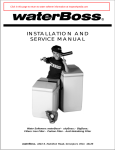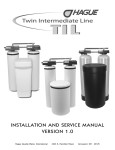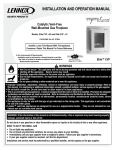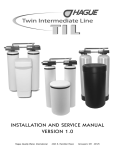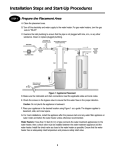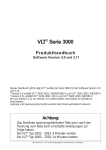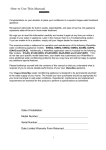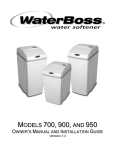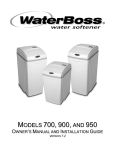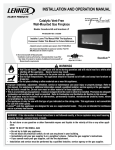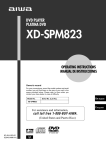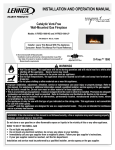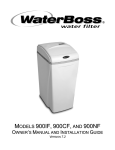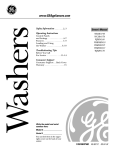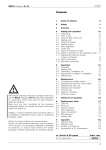Download Model 5100 Manual - Aqua Tech Water Conditioning
Transcript
MODEL 5100 Water Conditioner INSTALLATION AND SERVICE MANUAL Ver. 3.0 4343 S. Hamilton Road, Groveport, Ohio 43125 Congratulations on your decision to place your confidence in our superior water treatment appliance. Recognized worldwide for built-in quality, dependability, and ease of service, this appliance represents state-of-the-art in home water treatment. Important information is contained in this manual which will help you get the maximum benefit and enjoyment from your particular model. We urge you to read this information carefully now and any time a malfunction may occur. In most cases, these reviews will uncover minor problems that you can correct yourself, thereby saving you time and the cost of an unnecessary service call. Date of Installation: ________________________________ Model Number: __________________________________ Serial Number: ___________________________________ Returned Limited warranty Card Date: ________________ Table of Contents GETTING MAXIMUM EFFICIENCY FROM YOUR APPLIANCE ............................... 1 INSTALLATION CHECKLIST ..................................................................................... 2 DO'S AND DON'TS .................................................................................................... 3 REFERENCE ILLUSTRATIONS ................................................................................. 4 INSTALLATION AND START-UP PROCEDURES ..................................................... 8 SETTING THE CONTROLLER.................................................................................... 10 CYCLE SETTINGS ..................................................................................................... 13 PARTS DIAGRAMS .................................................................................................... 14 TROUBLESHOOTING ............................................................................................... 28 SOFTENER SPECIFICATIONS ................................................................................. 30 LIMITED WARRANTY ................................................................................................ 31 How To Get The Maximum Efficiency From Your Appliance 1. Fill salt cabinet when water level is above salt level. DO NOT MIX DIFFERENT TYPES OF SALT. If iron is present in your water, use a salt with an iron-cleaning additive to help keep the resin clean. You may also use a resin cleaner on a monthly basis in place of salt with cleaning additives. If iron is not present in your water, a clean pellet, solar or cube type salt is recommended. The use of rock salt is not recommended because it contains impurities that may plug the injector assembly. (See page 18.) 2. You may use a salt substitute (such as potassium chloride) in place of water conditioner salt. If you start with water conditioner salt, you can switch to a salt substitute at any time or vice versa. If potassium chloride is used in place of nugget or pellet salt, you must select the potassium option during the programming of the controller. We do not recommend using Potassium Chloride if there is iron in your water. 3. Should your electricity be turned off for any reason you must reset time of day. (See page 12) 4. Protect your appliance from freezing, including drain line. 5. By-pass the appliance when servicing the well, plumbing, or pump. When work is completed, turn on the nearest cold water tap until water runs clear before putting appliance back in service. See figures 4 - 5 - 6. NOTES 1 Installation Checklist 1. Water Pressure - Not less than 20 psi constant. See page 30. 2. Double check hardness - of water with test strips provided to verify that your appliance is right for the job. See page 12. 3. Water Supply Flow Rate - 5 gallons per minute is recommended as minimum. 4. Drain - Drain appliance to floor drain or washer drain. To prevent back-siphoning, the installer must provide an adequate air gap or a siphon break. See figure 1. 5. Electricity - The transformer supplied is a standard 120 volt, 60 cycle A.C. for USA or 220 volt, 50 cycle A.C. for outside the USA. See figure 8. 6. Water Quality - If water supply contains sulfur, bacteria, iron bacteria, tannins, algae, oil, acid, dirt, sand or other unusual substances, special equipment must be installed with the system. NOTES 2 Do’s And Don’ts SOME DO'S 1. Do comply with all local plumbing and electrical codes. 2. Do install pressure-reducing valve if inlet pressure exceeds 90 psi. 3. Do install gravity drain on salt storage cabinet. See figure 7. 4. Do secure drain line on appliance and at drain outlet. See figure 3. 5. Do allow a minimum of 8 to 10 feet of pipe from the outlet of the water conditioner to the inlet of the water heater. See figure 1. SOME DON'TS 1. Do not install if checklist items are not satisfactory. 2. Do not install if incoming or outlet piping water temperature exceeds 120 degrees Fahrenheit. Please see specifications on page 30. 3. Do not allow soldering torch heat to be transferred to valve components or plastic parts. 4. Do not overtighten plastic fittings. 5. Do not place appliance right up against a wall which would deny access to plumbing. See figure 1. 6. Do not install the appliance backwards. Follow arrows on inlet/outlet. See figure 2. 7. Do not plug the transformer into an outlet that is activated by an on/off switch. See figure 8. 8. Do not connect the drain and the overflow (gravity drain) together. See figure 1. 3 Reference Illustrations Figure 1 - Installation Guide OR Use this diagram as a location and installation guide for your water conditioner. This diagram applies to basement, slab, crawl space and outside installations. Bypass Valves. To simplify installation and servicing, a one-piece or a three way bypass valve system is recommended when installing your appliance. A bypass system also provides access to untreated water when required (i.e. for lawn and gardening purposes.) Also, see figures 4 through 6. Caution: A minimum of 10 feet of 3/4” pipe from the outlet of the water treatment appliance and the inlet to the water heater is recommended. 4 Reference Illustrations Figure 2 INSTALLATION TIP When preparing the male threaded fittings of the I/O adapter, follow the guidelines to avoid damage to the plastic pipe threads. 1. For best results, use 1/2” wide Teflon® tape and wrap the threads three times with each consecutive wrap on top of the previous wrap. To prevent tearing of the the tape, use Teflon® paste on the first two threads only. This lubricates the tape and fills the small void areas that may exist between the threads. When the joint is complete, there will be a small bead of sealant at the fitting interface indicating a properly joined connection. PLUMBING CONNECTIONS Copper, brass, plastic or other fittings may be used. DO NOT over-tighten fittings. 2. When preparing copper fittings, it is always advisable to use a union where there is a threaded connection to facilitate repairing a potential leak in one of your soldered joints. Figure 3 3. To prevent heat damage to the plastic pipe threads of the adapter, prepare the copper tail assemblies ahead of time so they can cool down before final assembly. The copper tube length should be a minimum of 4-1/2” long. To prevent cross threading, turn the fitting counterclockwise until you feel the threads engage, then tighten. Do not overtighten the fittings. CAUTION NOTE: To avoid damage, do not allow heat from the torch to be transferred to the plastic valve component. CONNECTING DRAIN LINE CAUTION! The drain line must not be kinked, crimped or restricted in any way. The drain line 1/2" inside diameter cannot be reduced in size. 5 Reference Illustrations Figure 4 Bypass Valves (Optional) Part #93884 <push/pull> for service or bypass. This part may be available through your dealer. Figure 5 Figure 6 IN BYPASS POSITION IN SERVICE POSITION 6 Reference Illustrations Figure 7 OVERFLOW CONNECTION Figure 8 Figure 9 PLUGGING IN TRANSFORMER Do not plug transformer into an outlet that is controlled by on/off switch. ADDING SALT TO THE BRINE CABINET 7 Installation And Start-Up Procedures Each water conditioner includes 8' of drain line and a drain fitting. 1. Placement. Place your appliance in desired location. Turn off electricity and water supply to water heater. Make sure inlet/outlet and drain connections meet the applicable local codes. Check arrows on valve to be sure water flows in proper direction. See figures 1, 2, & 3. CAUTION: DO NOT PLUMB APPLIANCE IN BACKWARD. 2. Connecting Water Lines. Lift and remove the valve cover. Attach the water lines to the in and out connections. Do not over tighten connections on the plastic threads. Check inlet connection and outlet connection to be certain water flows in the proper direction. (As you face the front of the appliance, the inlet is on the left and the outlet is on the right.) See figure 2 3. Drain Line. The drain line must be a minimum of 1/2" I.D. tubing and should make the shortest run to a suitable drain. The drain line may be elevated up to 8 feet from the discharge on the appliance as long as the water pressure in your system is 40 psi or more. If drain line is 25' or longer, increase drain line to 5/8" I.D. Also, the end of the drain line must be equal in height or lower than the control valve. See figure 1. 4. Flushing. Before placing your appliance in service, it is very important to flush the cold water lines of any debris. Turn on water supply, open the nearest cold water tap and let the water run for 2 to 3 minutes until the water flows clear. Then put the by-pass in the Service position. See figures 4 through 6. 5. Check Leaks. Close faucet and check for leaks. If leaks are found, turn off main water supply and open the nearest cold water faucet to depressurize lines. Close faucet to eliminate siphoning action. Repair leaks. Turn on water supply and electricity to water heater. Place the bypass valve in the Service position. See figure 6. 6. Connect Overflow Line. (See figure 7.) The overflow line is used to direct excess water to a floor drain if the brine tank fills with to much water, or the appliance malfunctions. The overflow line must end at a drain that is at least 3" lower than the bottom of the overflow fitting. It is a gravity line and cannot be run overhead. See figure 1. 7. Complete The Installation. Open a cold water tap and allow the appliance to flush for 20 minutes or until approximately 72 gallons has passed through the appliance per NSF requirements. 8. Plug In Transformer. See figure 8. 8 Installation And Start-Up Procedures 9. Water Testing. The water conditioner, like any other appliance, requires correct installation and setting for optimum performance. To ensure proper settings, you need to obtain an accurate water test. Do this as follows: For municipally supplied or “City” water, call your water utility company. Ask them the hardness, iron content and pH levels of your water. For well water, have a sample of your untreated water tested for hardness, iron and pH. To find a facility to test your water sample, check your Yellow Pages under Water Analysis or Water Testing; inquire at your selling dealer; or contact the company below to conduct a test for you. WATERSCREEN National Testing Laboratories, Inc. 1-800-458-3330 - 9 am - 5 pm EST If you feel you have an abnormal amount of iron, be sure to use salt with an iron-cleaning additive. . 10. Adding Water & Salt. Be sure to remove any packaging or installation materials before adding salt. Next, add not more than 3 gallons of water to the brine cabinet. Then add salt to the brine cabinet, wait 2 hours then push the regen button and hold for 5 seconds. A regeneration cycle will begin and continue for approximately 37 minutes. After the first regeneration, your appliance will automatically refill the correct amount of water in the brine cabinet. See figure 9. 11. Refill Salt when the salt level drops below the water level in the brine cabinet. Always keep salt above water level. See figure 9. CAUTION! Failure to install, operate and maintain your water treatment appliance as instructed will VOID the product limited warranty. NOTE! Make sure the Owner's Limited warranty Card is filled in and mailed within 30 days of installation. NO POSTAGE REQUIRED. 9 Setting The Controller SERVICE SETTINGS This section is recommended for qualified service personnel only. The appliance control must be set correctly for proper performance. REGENERATE FUNCTION: Multi-purpose. 1.) Used to put the appliance into an immediate regeneration. Press and hold (approximately 5 seconds) until display changes to "Going to 1". The appliance is now in regeneration and will return to "Gal. Remain" after completion of all cycles. 2.) Used to “speed up” or toggle through all the regeneration cycles. Gal. Remain 00718 CUSTOMER SETTINGS This section is recommended for qualified service personnel only. Must be set correctly for proper performance. CHANGE FUNCTION: Used to change values of parameters that can be set. Used in conjunction with SELECT button. Press and release the Select Digit button to move cursor one digit to the right of parameter that can be set. When cursor is at extreme right position, press again to reset cursor to extreme left position. Figure 10 SELECT FUNCTION: Used to control cursor movement when in CUSTOMER & SERVICE SETTINGS modes. Used in conjunction with CHANGE button. Press and release the Select Digit button to move cursor one digit to the right of parameter that can be set. When cursor is at extreme right position, press again to reset cursor to extreme left position. DISPLAY FUNCTION: When pressed and held, “CUSTOMER SETTINGS” is displayed. Hold for 5 seconds and the customer programming mode is entered. Used simultaneously with the SELECT button to enter service settings program mode, press and hold both buttons for 5 seconds while holding “SERVICE SETTINGS” is displayed. (Note: both buttons must be pressed.) SCROLL BACK FUNCTION: Used to toggle back to the previous parameter setting in the event of a mistake in programming. This feature eliminates the need to toggle through the entire program to correct an input error. CONTROL PANEL DISPLAY: LCD DISPLAY FUNCTION: Shows status of control; NORMAL OPERATING mode, SERVICE SETTINGS mode or CUSTOMER SETTING mode. It is very important to know which mode the control is in for proper operation. WATER FLOWING INDICATOR FUNCTION: Shown in the LCD display, it indicates that water is flowing through the appliance. Flow rate is displayed in gallons per minute. This is useful for checking for proper plumbing and leaks. Description Of The Two Operating Modes CAUTION: Be sure the controller is firmly "locked" onto the drive end cap assembly." The four tabs on top of the drive end cap will allow the clips on the bottom of the controller case to lock onto the end cap tabs. (See detail diagram on page 14; fig. 11.) MODE 1 TIMER MODE: Will regenerate based on frequency. Example: every 2 days or as specified up to 12 days. Time of regeneration can be set. MODE 2 PATENTED SAVEMATIC - DEMAND DELAYED: Is based on actual water usage and total capacity of the appliance. Time of regeneration can be set. If total capacity is depleted before set regeneration time, a forced regeneration will occur. Note: Mode 1 and 2 are equipped with capacity Gard. This ensures that you do not run out of conditioned water due to excess water usage. 10 Setting The Controller - Continued THE FOLLOWING EXAMPLE takes you through the steps involved for setting the controller. If you follow these steps, you will set the unit to OPERATING MODE 2, DEMAND DELAYED operation. Mode 1 uses a similar procedure. It is necessary to enter the “SERVICE SETTINGS” first, followed by the “CUSTOMER SETTINGS”. Press and hold the SELECT and DISPLAY buttons simultaneously for 5 seconds. The display will show, Set Language Eng. Release both buttons. 1.00 Push the DISPLAY button to step to the next parameter. The display will show: Units ENG 1.00a Push the CHANGE button to toggle English/metric units of measure. For this example, set to: Units ENG. 2.00 Push the DISPLAY button to step to the next parameter. The display will show: soft.V.#1.07. This parameter cannot be set. 3.00 Push the DISPLAY button to step to the next parameter. The display will show: Mode 2 The “Mode #” is the number of the OPERATING MODE for which the controller is set. For this example, leave at: Mode 2. 4.00 Push the DISPLAY button to step to the next parameter. The display will show: Hard. Gr. 040 The 040 is the hardness number of the water tested. This number is to be the actual hardness reading and is not compensated for iron. 4.00a Push and release the SELECT button until the cursor ( _ ) is positioned in the display as follows: Hard. Gr. 040. The cursor is now under the "ten" position. 4.00b Continue pushing the SELECT and CHANGE buttons until the desired hardness number is displayed. Example: Hard. Gr. 025 5.00 Push the DISPLAY button to step to the next parameter. The display will show: Iron ppm 00 This parameter is used to calculate a compensated hardness automatically. 5.00a Push the SELECT and CHANGE buttons until the desired iron number is displayed. Example: Iron ppm 00 6.00 Push the DISPLAY button to step to the next parameter. The display will show: Mang. ppm 00 6.00a Push the SELECT and CHANGE buttons until the desired manganese number is displayed. Example: Mang. ppm 00 6.00b Push the DISPLAY button to step to the next parameter. The display will show: SALT = Sodium. WARNING! When iron and/or manganese is present in the water supply, do not use potassium chloride as a regenerant. Iron and/or manganese bacteria may develop and foul the conditioning media and may void the warranty. 6.00c Push the CHANGE buttons until the desired regenerant is selected. EXAMPLE: Salt = Sodium. 7.00 Push the DISPLAY button to step to the next parameter. The display will show: Comp. Hard. 00025 This parameter is the calculated compensated hardness using the hardness, iron and manganese settings. The formula is (4 x each ppm iron) + (4 x each ppm manganese) + hardness = compensated hardness. This is not a parameter that can be set. The display should now read: Comp. Hard. 00025 8.00 Push the DISPLAY button to step to the next parameter. The display will show: Capty. Gr. 24480 This parameter is used to set the softening capacity of the appliance. (See softener specifications or setting charts for capacities based on salt usage.) 8.00a Push the SELECT and CHANGE buttons until the desired capacity number is displayed. In this example, set to: Capac. Gr. 24480 9.00 Push the DISPLAY button to step to the next parameter. The display will show: 72-96hr Regen Yes This parameter, if set to "Yes", is used to force the appliance to regenerate every 96 hours if regularly scheduled regenerations based on water usage do not occur in 96 hours or less intervals. This should always be "yes" if iron is present in the water. 9.00a Push CHANGE button to toggle parameter value from "No" to "Yes". In this example, set to: 96hr Regen No 10.00 Push the DISPLAY button to step to the next parameter. The display will show: Backwash 1 03.0 (See cycle settings, pg. 13.) The “03.0” is the time, in minutes to the nearest tenth, for which the first backwash cycle can be set. 10.00a Push the SELECT and CHANGE buttons until the desired backwash time is displayed. In this example, set to: Backwash 1 03.0 11 Setting The Controller - Continued 11.00 Push the DISPLAY button to step to the next parameter. The display will show: Brine/Rinse 30.0 The "30.0" is the time, in minutes to the nearest tenth, for which the first brine and slow rinse cycles can be set. 11.00a Push the SELECT and CHANGE buttons until the desired combined brine and slow rinse cycle time is displayed. In this example, set to: Brine/Rinse 30.0 12.00 Push the DISPLAY button to step to the next parameter. The display will show: Backwash 2 01.0 The "01.0" is the time, in minutes to the nearest tenth, for which the second backwash can be set. 12.00a Push the SELECT and CHANGE buttons until the desired backwash time is displayed. In this example, set to: Backwash 2 01.0 13.00 Push the DISPLAY button to step to the next parameter. The display will show: Salt lbs. 06.0 This parameter sets the amount of salt to be used to achieve the capacity setting. 13.00a Push the SELECT and CHANGE buttons until the desired salt setting is displayed. In this example, set to: Salt lbs 06.0 14.00 Push the DISPLAY button to step to the next parameter. The display will show: Turbine Test NO This feature should only be used by qualified service personnel. It is intended to be used for diagnostic purposes only. WARNING! Do not engage this feature. 14.00a Push the SELECT and CHANGE buttons until the correct value is displayed. In this example, set to: Turbine Test NO 15.00 Push the DISPLAY button to step to the next parameter. The display will show: Reg. Tonight NO This parameter, if set to YES, will force a regeneration at the next set regeneration time (i.e. 02.00.) After the regeneration, the parameter will automatically reset to "No." 15.00a Push the CHANGE button to toggle between Yes or No. In this example, set to: Reg. Tonight YES 16.00 Push the DISPLAY button to step to the next parameter. The display will show: Filter? No. This parameter, if set to YES, is for model selection only and has no effect on the function of the appliance. In this example, set to: Filter, NO. 17.00 Push the DISPLAY button to step to the next parameter. The display will show: Gal. Remain 00979 This is the normal operation display for OPERATING MODE 2. The 00979 represents the number of gallons of softening capacity between regenerations. This completes the SERVICE SETTINGS mode. Even though the SERVICE SETTING mode has been completed, the appliance is not ready for service until the CUSTOMER SETTINGS mode is completed. The following example takes you through the steps required for setting the parameters of the CUSTOMER SETTINGS mode for OPERATING MODE 2. 1.00 Push and hold the DISPLAY to enter CUSTOMER SETTINGS mode. The display will show: Set Time 00:00 AM This parameter is to be set to the current time of day. 1.00a Push the SELECT and CHANGE buttons until the desired time is displayed. In this example, set time to: Example: 11:00 AM or 05:00 PM. 2.00 Push the DISPLAY button to step to the next parameter. The display will show: Reg Time 02:00 AM This parameter is to be set for the desired time a normally scheduled regeneration is to occur. 2.00a Push the SELECT and CHANGE buttons until the desired time is displayed. In this example, set to: Reg. Time 02:00. (02:00 is 2:00am) 3.00 Push the DISPLAY button to step to the next parameter. The display will show: # People 04 3.00a Push the SELECT and CHANGE button until the correct number of people in the household is displayed. In this example, set to: # People 05 5.00 Push the DISPLAY button to save the parameter settings and exit the CUSTOMER SETTINGS mode. The display will show: Gal Remain 00979 If you followed the above directions correctly, your controller is ready for OPERATING MODE 2 service. 12 Setting The Controller - Continued CYCLE SETTINGS 3 lb. Salt Setting 1 lb. Salt Setting Service Setting Hardness Setting Number Iron ppm (clear water)* Capacity in Grains Backwash 1 (minute) Brine/Rinse (minute) Backwash 2 (minute) 96 Hour Regeneration Salt (lbs.) English Unit _______gpg ______ppm 5,410 03.0 07.0 01.0 YES/NO 1 6 lb. Salt Setting Service Setting Hardness Setting Number Iron ppm (clear water)* Capacity in Grains Backwash 1 (minute) Brine/Rinse (minute) Backwash 2 (minute) 96 Hour Regeneration Salt (lbs.) Service Setting Hardness Setting Number Iron ppm (clear water)* Capacity in Grains Backwash 1 (minute) Brine/Rinse (minute) Backwash 2 (minute) 96 Hour Regeneration Salt (lbs.) English Unit _______gpg ______ppm 15,054 03.0 14.0 01.0 YES/NO 3 9 lb. Salt Setting English Unit _______gpg ______ppm 24,480 03.0 30.0 01.0 YES/NO 6 Service Setting Hardness Setting Number Iron ppm (clear water)* Capacity in Grains Backwash 1 (minute) Brine/Rinse (minute) Backwash 2 (minute) 96 Hour Regeneration Salt (lbs.) English Unit _______gpg ______ppm 31,221 03.0 45.0 01.0 YES/NO 9 *When iron is present in the raw water supply, regeneration frequency cannot exceed 96 hyours. Also, a minimum salt setting of 6 lbs. is required and the #1 backwash must be increased to 7 minutes. 13 Parts Diagrams Figure 11 10 14 Parts Diagrams Figure 11 ELECTRONICS AND CABINET Figure# Part# Item Qty. 1 95204 Valve Cover Assembly 1 2 95205 Salt Port Lid 1 3 93245 12 Volt Transformer/Power Cord 1 4 95202 Cabinet 1 5 C0700 2 Piece Overflow 1 6 93848 Brine Tubing 7 95203 Support Panel 1 8 54550 Computer Control 1 9 90801 Cabinet Cover Clip 6 10 93832 Brine Line Hose Clamp 1 15 2 ft. Parts Diagrams Figure 12 16 Parts Diagrams Figure 12 Cabinet and Assemblies Figure# Part# Item Qty. 1 93521 3/4” I/O Adapter Assembly w/ Blending Valve 1 2 93838 3/4” I/O Adapter O-Ring 2 3 95505 Resin Tank Assembly (empty) 1 4 93808 End Cap O-Ring 2 5 95301T Drive End Cap Assembly 1 6 93870 Screw 4 7 90828 O-ring - Small End Cap 1 8 93501 Injector Assembly 1 M020-1 Fine Mesh Resin 1.0 cu ft 93702 Redox Filter Media 4 lbs 9 95202 Cabinet 1 10 93835 Spacer Tube 2 11 90614-2.4 Drain End Cap Assembly 1 1/2” FNPT 12 93809 Screw 2 17 Parts Diagrams Figure 13 Part Number 93501 Note: When working on the injector assembly, make sure part #3 aligns properly with the outline marked on part #4. 18 Parts Diagrams Injector Assembly Figure 13 Qty. Description Figure# Part# Item 1 93810 Injector Screen 1 Acts as a pre-filter to keep debris from entering the Injector Nozzle and Injector Throat. Attaches to the cylinder on the Nozzle plate and spherical "bump" inside the Main Valve Body. Some compression of the Screen may occur during assembly. The openings in the screen must be clear to ensure proper flow to the Injector assembly. 2 93223 Injector Throat 1 Creates the vacuum that draws the brine solution from the brine cabinet in conjunction with the Injector Nozzle (Part # 93221.) The center hole should be clear of debris, round and undamaged. The Injector Throat should be pressed flush into the opening in the valve. If the Throat needs to be removed, it should be replaced with a new one. 3 93220 Bottom (Thick) Injector Seal 1 Seals between the Injector Nozzle and the Main Valve Body. The gasket has a definite hole pattern that has to match-up with the Nozzle and Main Valve Body opening. The gasket seals at its outer edges and between the inlet screen and nozzle opening. These areas must be free of defects such as tears or pits and be free of debris. 4 93221 Injector Nozzle 1 Creates the vacuum that draws the brine solution from the Brine Cabinet in conjunction with the Throat (93233.) There are two openings in the Injector Nozzle plate. The small hole, flush on both sides, is the one that creates the "injection-stream" that enters the Injector Throat. It is very important that this hole be clear of debris, round and undamaged. If this hole becomes "clogged", do not use anything to clear this opening that could damage it, such as metal objects. Use a clean cloth and flush with water. If necessary, a wooden toothpick may be used. When assembling to the Main Valve Body, the Injector Nozzle hole should line up with the Injector Throat. 5 93232 Top (Thin) Injector Seal 1 Seals between the Injector Nozzle and the Injector Cap. The gasket must be free of defects such as tears or cuts and be free of debris. 6 93222 Injector Cap 1 Holds the Injector assembly together and seals the assembly to the Main Valve Body. 7 90807 Injector Screw 4 These four machine screws should be tightened evenly and snugly. 19 Parts Diagrams Figure 14 20 Parts Diagrams Figure 14 I/O Adapter Assembly (with blending valve) Item Qty. Description Figure# Part# 1 93521 3/4”I/O Assembly With Blending Valve 1 93521-1 1” I/O Assembly With Blending Valve* 1 2 90802 #6 X .500 Screw 3 3 90252 Blending Valve Cap 1 The Blending Dial Cap should be held in place by the three 1/2" screws and be in the proper orientation. 4 90222 Blending Dial 1 Permits the addition of "hard water" into the soft water outlet. It is closed when pointing toward the Main Valve Body and open when pointing toward the inlet side of the I/O Adapter. 5 90827 O-Ring 1 6 90232 Sensor Cap 1 7 90809 Screw, Sensor Cap 1 8 93858 Turbine Sensor Assembly 1 Picks up the magnetic field from the Turbine and relays it to the Controller. The three wire assembly connecting the "black-wafer" Hall-Effect Sensor to the Controller board must not be severely bent (folded over), cut, or broken. Care should be taken when putting the Sensor into the Sensor Housing. The “spring” flap below the Sensor must be gently bent over (on top of) the Sensor, and then the Sensor slide all the way into the Sensor Housing. The round hole of the Sensor mounting tab is then placed down over the mounting screw boss. The cap is then put in place and the mounting screw is installed. A slot is provided in the cap for the wire way to exit. The three-wire socket connector must be properly installed in the controller. Stops on the connector prevent improper (upside down) assembly. Do not force the connector past the stops. 9 90522 Turbine Assembly 1 The Turbine must have a 1/8" diameter Rare Earth magnet pressed into place adjacent to the axle opening. When assembled to the axle, the Turbine should spin freely. Do not use any lubricants. If the Turbine should become "jammed," clean and flush the Turbine and Bypass Valve. 10 93229 Flow Director 1 11 93838 O-Ring 2 * Available as an additional cost option. 21 Makes the connection between the plumbing and Main Valve Body. Also, contains the "Hard Water" Blending Valve. The seal areas of the O-rings at the Main Valve Body inlet and outlet must be smooth and free of defects and debris, and be lubricated with silicon grease before assembly. When attaching to the Main Valve Body, put the O-rings on the male bosses on the Main Valve Body and push the Adapter into place. A "snap" can be heard when the ADAPTER slides into place; if not, the O-rings may be "pinched." If O-rings are pinched, replace with new ones. The I/O Adapter comes pre-assembled with the sensor housing and turbine axle. These are not field serviceable and if damaged, must be replaced with a new assembly. The Sensor Cap should be snapped in place. Parts Diagrams Part Number 95301T Note: This asssembly does not include a magnet disk or drive motor and must be ordered separately. Figure 15 Figure# Part# Item 1 90809 Screw 2 2 90217 Drive Motor - 12V 1 3 93891 1/4” Hex Nut 2 4 93238 Drive Gear 1 5 90802 Screw 2 6 93219 Piston Slide Cam Cover 1 Piston Slide Cam 1 7 93217 Qty. Description The Drive Motor is held in place by two 1/2” screws. The screws should be “snug.” The brass pinion gear on the Motor should engage the plastic Drive Gear. The wires should be securely fastened to the Control. The Drive Gear is assembled to the Piston Slide Cam by means of a "keyed" opening which transfers the "torque" generated by the Drive Motor to the rest of the drive system. If the drive system becomes jammed, this opening can become "rounded" causing the gear to turn, but not the Piston Slide Cam. If this occurs, clear the jam and replace the Drive Gear and Piston Slide Cam (Part No. 93217.) The cover secures the Piston Slide Cam (93217) in place and acts as a bushing for the Cam Shaft. This is the "heart" of the drive system. There is a threaded stainless steel shaft that runs through the main drive axle. The Drive Gear is attached at the short end and the Magnet Disc at the other end. The Piston Slide Cam is assembled inside of the Piston Slide (93216). This Cam Shaft should turn freely before the Motor is assembled. 22 Parts Diagrams Figure 15 Drive End Cap Assembly Figure# Part# Item 8 93583 Drive End Cap 1 9 93216 Piston Slide 1 10 90818 Screw 2 11 93601 Brine Valve Housing Assembly 1 12 90821 O-Ring 1 13 54502 Magnet Disk Assembly 1 14 90828 O-Ring 1 15 93808 O-Ring 1 16 93522-A Piston Assembly 1 17 93839 1 Drain Gasket Description Seals the two openings on the Main Valve Body. The larger diameter opening is sealed with an O-ring used as an axial or "face" seal. The O-ring sits in a groove in the End Cap. This groove must be free of defects such as pits or scratches and also free of debris. The smaller diameter seal is accomplished with an O-ring used as a radial seal. The O-ring should be placed on the male boss on the End Cap. When assembling the Drain End Cap to the Main Valve Body, care should be taken to make sure the small O-ring is aligned with the opening in the Main Valve Body and that the large O-ring stays in the groove in the Drive End Cap. If misaligned, the O-rings can become pinched and leak. The Piston Slide should move freely inside the Drive End Cap Housing. The stainless steel threaded stud should be pointing toward the Main Valve Body. Attaches to the Drive End Cap with two 3/4" thread cutting screws and has one O-ring seal. When assembling, the O-ring should be placed on the Drive End Cap boss and be lubricated with silicone grease. A twisting action should be applied along with pressure until the O-ring seats. (See Brine Valve Assembly sheet for more details.) The Magnetic Disc is assembled to the Piston Slide Cam by means of a “keyed” opening to ensure proper orientation. The magnet in the Magnetic Disc should be flush with the disc surface. The Piston should be screwed onto the Piston Slide Cam until it “bottoms out,” but care should be taken not to overtighten. Overtightening can cause the Piston to break. The white Teflon Hydro-slide O-Ring covers should be free of defects such as indentations and cuts. The Drain Gasket should slide - there will be some friction - without binding on the Piston shaft. When assembling, care should be taken to insert the Piston into the Main Valve Body without excessive side-to-side or up/down motion. 23 Parts Diagrams Figure 16 Part Number 93601 Brine Valve Housing Assembly Figure# Part# Item Qty. 1 93620 Piston Assembly 1 2 90821 O-Ring 1 3 93260 Housing 1 4 93878 Quad Ring 1 5 93254 Quad Ring Retainer 1 6 90843 .5 gpm Flow Control 1 7 93805 O-Ring 1 8 93243 Housing Cap 9 90807 Screw Description The Piston should have a gasket on the shaft side of the flange and a spring pressed onto a boss on the other side. The gasket should be free of defects such as cuts or debris. The Piston is Teflon coated and should be free of scratches. The Piston should move freely in the housing; silicone lubrication is recommended on the Piston shaft. Should have the captured Quad-ring for the Piston seal. The Quad-ring retaining button is Ultrasonically welded into place and cannot be removed from the Housing. There should be a visible "bead of weld" near the exit hole of the Brine Valve Piston. Just inside the entrance hole for the Brine Piston is the raised seat area. This "raised ring" should be free of defects such as nicks, indentations or debris. If any of these defects exist, the piston will leak water into the Brine Tank until the Safety Shutoff engages. This type of defect can be detected by visual inspection or while the unit is pressurized, disconnecting the brine line and watching for "dripping" water. The Flow Control has two distinct and different sides. One is "flat"; the other is "concave." The button should be centered in the housing opening with the four locator "ribs" with the concave side facing the Housing Cap. Held in place by two 5/8" machine screws that engage the Housing flange. An O-ring seals the Housing Cap and Housing. Place the O-ring into the housing opening, lubricate with silicone grease and then use a twisting action and pressure to insert the Housing Cap. 2 24 Parts Diagrams ? ? ? ? ? ? ? ? Part Number 93811-20.0 ? Figure 17 Safety Shutoff Assembly Figure# Part# Item Qty. 1 51366 Air Check Elbow Assembly 1 Make sure compression nuts are tight. 2 H7041 Guide and Lock Set 1 Should not be loose. 3 H7039 Float Grommet 2 Used to adjust the height of the float. 4 H7040 Bell Float 1 5 H7042 Float Washer 1 6 H7038 Float Rod 1 7 93811-20.0 Air Check / Brine Well Assembly 1 8 CO700 2-Piece Overflow 1 25 Description Parts Diagrams Part # 90614-2.4 Figure 18 Drain End Cap Assembly Figure# 1 Part# 93808 Qty. O-Ring 1 Drain End Cap Assembly (1-4) 1 Drain End Cap (threaded) 1 1 (H2086-3.0*) Drain Line Flow Control Button 90267 Retainer 1 90614-2.4 2 90268 3 H2086-2.4 4 Item Description Seals the left opening on the Main Valve Body. The opening is sealed with an O-ring used as axial or "face" seal. The O-ring sits in a groove in the End Cap. This groove must be free of defects such as pits or scratches and also free of debris. When assembling the Drain End Cap to the Valve Body, care should be taken to make sure that the O-ring stays in the groove in the Drain End Cap. If misaligned, the O-ring can become pinched and leak. Maintains a constant (plus or minus 10%) backwash flow rate at varying pressures. Care should be taken when replacing Drain Line Flow Control Buttons to ensure that the correct rate is being used for a particular model unit. Flow Control Button should be assembled with lettering facing retainer. Holds the backwash Flow Control Button in place. One side is smooth and the other has a groove for a screwdriver. When assembling the retainer to the Drain End Cap, the retainer should be "screwed" in until it stops. If the retainer is not fully engaged, the Flow Control may not function properly. *Use this flow control for models with a B1or P1 designation (e.g. 5100PTB1). 26 Parts Diagrams Figure 19 Fill Plug Assembly, Tank Bottom 27 Troubleshooting Problem No soft water after regeneration. No soft water. No flow is indicated when water is flowing. Flow is indicated when water is not being used. Cause Solution No salt in brine cabinet. Add salt (refer to "Regenerate" Page 10) Sediment in brine tank has plugged the brine line and air check (page 25). Remove air check draw tube and flush with clean water. Clean injector assembly. Clean any sediment from brine cabinet. Drain line is pinched, frozen or restricted. Straighten, thaw or unclog the drain line. Clogged injector assembly (page 18, 19). Remove injector cap and clean nozzle and throat with a wooden toothpick. Replace throat if removed. Salt bridge has formed. High humidity or the wrong kind of salt can create a salt bridge. This is a crust that forms an empty space between the water and salt. To test, use a blunt object like a broom handle. Push the handle into the salt to dislodge the salt bridge. The plumbing bypass valve is in the the bypass position (page 6). Place bypass valve in the service position. Appliance is plumbed backwards. Check that appliance is plumbed correctly. Extended power outage. Reset hardness (refer to “Regenerate” Page 10). Water hardness has increased. Reset water and reset hardness. Not metering water. Flow should be indicated with water usage. If no flow, see below. The plumbing bypass valve is in the the bypass position (page 6). Place bypass valve in the service position. Appliance is plumbed backwards. Check that unit is plumbed correctly. Sensor not receiving signal from magnet on turbine (page 20, 21). Remove sensor from IO housing. Test by placing magnet on the sensor chip. If flow is indicated, replace turbine. If no flow, replace sensor. There is a leak in your hosehold plumbing system. Repair the leak. 28 Troubleshooting Problem No read-out in display. Appliance stays in regeneration. Cycle numbers remain flashing. Excess water in brine tank. Should be approximately 8 - 10" with salt. Not regenerating in proper sequence. Salty water after a regeneration. Cause Solution Electric cord is unplugged. Plug in transformer. No electric power at outlet. Check power source. Make sure outlet is not controlled by a switch. Defective transformer (fig. 8). Test with volt meter for 12 VAC at control. If 0 VAC, replace transformer. Defective circuit board (fig. 10). With 12 VAC present at controller, replace circuit board. Computer control not attached properly. Make sure computer control is pushed all the way onto drive end cap. Foreign object in valve body. Remove foreign objects from valve body. Broken valve assembly. Motor running. Magnet disc not turning (pages 22, 23). Replace drive end cap. Restricted, frozen or pinched drain line. Remove restriction, thaw or straighten drain line. Plugged brine line, brine line flow control or air check (pages 24, 25). Clean flow control, air check and brine line. Clean any sediment from brine cabinet. Plugged injector assembly (pages 18, 19). Clean or replace injector. Replace throat if removed. Sticking brine refill valve. Remove valve. Lubricate piston with silicone grease and reassemble. Magnet disc defective. Replace magnet disc. Defective position sensor. Replace control. Plugged Injector. Clean injector screen, nozzle and throat. Low water pressure. Maintain min. pressure of 30 psi. Drain line or flow control restricted. Remove restrictions. Brine line restricted or crimped. Remove restrictions, replace if crimped. Excessive amount of water in brine cabinet. Verify correct water level relative to salt setting. Check lines for loose connections. Insufficient rinse time. See page 13 for proper rinse time. Intermittent pressure drop from feed source. Verify adequate pressure and volume of water supply. 29 Softener Specifications MODEL 5100 Maximum compensated hardness (grains) 90 10 ppm Maximum ferrous iron reduction 7 Minimum pH PowerClean Media - 1.5 lbs Super Fine Mesh Resin - 1.0 cu. ft. Optional Redox media - 2 lbs. Media type and amounts 4.0 / 20,000 Salt usage (lbs.) / Capacity 5,700 1 Lb. Salt Setting See Cycle Settings, Page 13. 3 Lb. Salt Setting 6 Lb. Salt Setting 15,054 24,480 31,221 9 Lb. Salt Setting Maximum water temperature 120ºF Mineral tank size 10.5 X 21” I.D. Peak flow rate / psi drop 10 gpm/14.5 Pressure drop @ service flow rate of 4 gpm 4.0 Maximum flow rate to drain during regeneration (gpm) 3.0 Water Pressure (minimum-maximum psi) Minimum water volume required (backwash (gpm) Controller type 20 / 120 2.4 5 Button Regeneration time (minutes) 37 Water used per regeneration (gallons) 21.8 Frequency of regeneration (days) Demand Salt Storage 170 lbs. Height (in.) 30.5” Footprint (in.) 15” X 26” Electrical Rating 12VAC, 1 phase60 Hz Plumbing Connections* 3/4 ” MNPT Shipping Weight - Approximate (lbs.) 105 lbs * Optional 1” I/O adapter assembly available - Part # 93521-1 30 Limited Warranty Warranty Information To place this appliance under limited warranty, the limited warranty registration card must be completed and returned within 30 days of installation. Coverage - This limited warranty covers the appliance delivered to the original owner when the system is purchased for personal, family, or household use. It is intended to cover defects occurring in workmanship or material or both. Warrantor's Performance and Length of Limited warranty - warrants that upon receipt from the original owner of any mechanical or electronic part which is found to be defective in material or workmanship, warrantor will repair or replace the defective item for 3 years from date of installation. Warrantor further warrants that upon receipt from the original owner of any warrantor media tank/valve body, brine cabinet, found to be defective in material or workmanship, warrantor will repair or replace the defective item for 10 years from date of original installation. There are no warranties other than those described in this limited warranty instrument. This limited warranty does not cover any service call or labor costs incurred with respect to the removal and replacement of any defective part or parts. Warrantor will not be liable for, nor will it pay service call or labor charges incurred or expended with respect to this limited warranty. In the event the water supply being processed through this product contains bacterial iron, algae, sulphur, tannins, organic matter, or other unusual substances, then, unless the system is represented as being capable of treating these substances in the system specifications, other additional treatment of the water supply must be used to remove these substances before they enter this product. Otherwise, warrantor shall have no obligations under this limited warranty. This limited warranty does not cover damage to a part or parts of the appliance from causes such as fire, accidents, freezing, or unreasonable use, abuse, or neglect by the original owner. This limited warranty does not cover damage to a part or parts of the system resulting from improper installation. All plumbing and electrical connections should be made in accordance with all local codes and the installation instructions provided with the system. The limited warranty does not cover damage resulting from use with inadequate or defective plumbing inadequate or defective house wiring; improper voltage, electrical service, or electrical connections; or violation of applicable building, plumbing, or electrical codes, laws, ordinances, or regulations. This limited warranty does not cover incidental, consequential, or secondary damages. Any implied warranties on the product described in this limited warranty will not be effective after the expiration of this limited warranty. Some states do not allow limitations on how long an implied limited warranty lasts or the exclusion or limitation of incidental or consequential damages, so the above limitations and exclusion may not apply to you. This limited warranty gives you specific legal rights and you may also have other rights which vary from state to state. 31 The WQA Gold Seal assures that this product has been tested and validated by the Water Quality Association. This validation assures that all electrical components are UL or CSA listed and all components that are in contact with the treated water are FDA or NSF listed. Listed and tested under NSF Standard 44 for Softening Performance, Barium Reduction, and Radium 226/228 Reduction. Water softeners using sodium chloride for regeneration add sodium to the water. Persons who are on sodium restricted diet should consider the added sodium as part of their overall sodium intake. Made in USA. Manufactured using one or more of the following patent numbers: 5,089,140. 5,300,230. DES.332,480. DES.331,097. 5,116,419. 5,157,979. 5,378,370. ©1998 William R. Hague, Inc. P.O. Box 298, Groveport, OH 43125 LITHO USA Form 51900PT RV1103HQWI






































